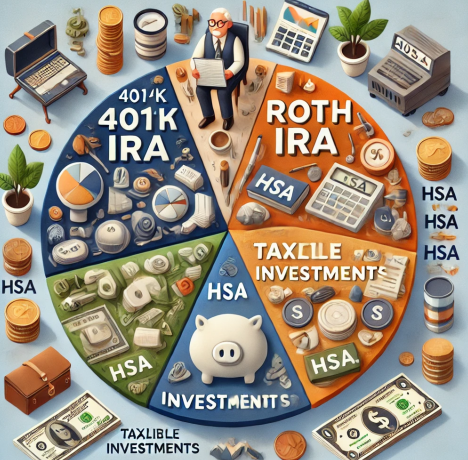The Impact of Tax-Deferred Accounts on Retirement Planning
Retirement planning is a cornerstone of financial stability, yet many individuals overlook the profound benefits of tax-deferred accounts. These vehicles—such as 401(k)s, IRAs, and annuities—allow your investments to grow without immediate tax liabilities, amplifying long-term wealth. People In their 20's and 50's have disposable income. understanding how to leverage these accounts can mean the difference between a comfortable retirement and financial uncertainty. This article explores the mechanics, advantages, and strategic uses of tax-deferred accounts, empowering you to make informed decisions for your future.

1. What Are Tax-Deferred Accounts?
Tax-deferred accounts are financial tools that delay taxes on contributions and earnings until withdrawal. Unlike taxable brokerage accounts, where dividends and capital gains are taxed annually, these accounts let your money compound without annual tax drag. Common examples include:
- Traditional 401(k) and IRA: Contributions reduce taxable income today, but withdrawals in retirement are taxed.
- Deferred Annuities: Insurance products that grow tax-free until payouts begin.
- Health Savings Accounts (HSAs): Triple tax-advantaged if used for medical expenses, but can also serve as retirement tools.
Why does this matter? By deferring taxes, you retain more capital to invest, accelerating growth over decades. For example, a $10,000 annual contribution to a 401(k) could save a 24% taxpayer $2,400 yearly in immediate taxes—money that stays invested.
2. The Power of Compounding Without Tax Drag
Tax-deferred accounts supercharge compounding—the process where earnings generate their own earnings. Consider this hypothetical:
- Taxable Account: $10,000 invested annually, 7% annual return, 15% capital gains tax. After 30 years: ~$913,000.
- Tax-Deferred Account: Same inputs, but taxes apply only at withdrawal (assumed 22% rate). Result: ~$1,032,000.
The difference? $119,000 more in the tax-deferred account, despite a higher tax rate at withdrawal. This illustrates how delaying taxes preserves growth momentum.
Real-World Application: A 30-year-old contributing $500/month to a 401(k) could accumulate over $1.2 million by age 65 (assuming 7% returns). You have to pay tax on dividends in a nonexempt account. gains might reduce this by 20–30%.

3. Tax Brackets in Retirement: A Strategic Advantage
Many retirees fall into lower tax brackets than during their working years. For example:
- A couple earning $150,000 annually might pay 22–24% federal taxes today.
- In retirement, required withdrawals from tax-deferred accounts could be taxed at 12–22% if their income drops.
Key Insight: By deferring taxes, you effectively shift income to a period with potentially lower rates. This is especially valuable for high earners who expect reduced income post-retirement.
Case Study: Sarah, 45, earns $200,000/year. She contributes $23,000 annually to her 401(k), saving $5,520 in taxes (24% bracket). At 65, she withdraws $80,000/year, taxed at 12–22%. Her lifetime tax savings? Over $200,000.
4. Avoiding Common Pitfalls
While tax-deferred accounts are powerful, missteps can erode their benefits:
Over-Contribution Penalties: Exceeding IRS limits (e.g., $23,000 for 401(k)s in 2024) triggers a 6% excise tax.
Lack of Diversification: Relying solely on tax-deferred accounts may limit liquidity. Balance with Roth IRAs or taxable investments.
It's a good idea to tap funds earlier the age of 18. 59½ incurs a 10% penalty plus income taxes. Exceptions exist for hardships, but it’s best to avoid.
Pro Tip: Use HSAs for medical costs first, but let unused funds grow for retirement. After 65, withdrawals for any purpose are penalty-free (though taxed if non-medical).

5. Strategies to Maximize Tax-Deferred Benefits
Tailor your approach based on age and income:
In Your 20s–30s: Prioritize 401(k) contributions up to employer matches, then max out Roth IRAs for tax-free growth.
In Your 40s–50s: Increase 401(k) contributions as earnings rise. Consider "catch-up" contributions ($7,500 extra for 401(k)s at 50+).
It's nearing retreat and you receive to shift to a new currency. during low-income years to reduce future Required Minimum Distributions (RMDs).
Advanced Move: Pair tax-deferred accounts with a Roth IRA ladder. Convert portions of your 401(k) to Roth IRA gradually, paying taxes at lower rates and creating tax-free income streams.
6. The Role of RMDs and Longevity Planning
Tax-deferred accounts come with RMDs—mandatory withdrawals starting at age 73 (as of 2024). A 25% penalty is imposed if you fail to take RMDs.
Solution: Project RMDs using IRS life expectancy tables. If RMDs push you into a higher bracket, consider:
- Donating to charity via Qualified Charitable Distributions (QCDs).
- Reinvesting surplus funds in taxable accounts.
Longevity Risk: With life expectancies rising, tax-deferred accounts ensure you don’t outlive your savings. A $1 million 401(k) at 65 could provide $40,000/year for 25+ years, adjusted for inflation.
Conclusion: Building a Tax-Efficient Retirement
Tax-deferred accounts are not just tools—they’re accelerators for wealth creation. By minimizing annual tax drag, leveraging compounding, and strategically timing withdrawals, you can unlock 20–30% more retirement income. Start early, diversify your tax buckets (tax-deferred, tax-free, and taxable), and consult a financial advisor to tailor strategies to your goals. Remember, the best retirement plan isn’t just about saving—it’s about optimizing every dollar for the future.
(Writer:Lany)





